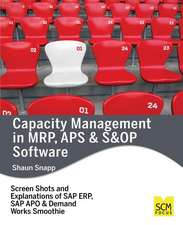Software Process Modeling: International Series in Software Engineering, cartea 10
Editat de Silvia T. Acuna, Natalia Juristoen Limba Engleză Hardback – 10 mar 2005
The computer audience is placing growing demands on the software industry today. Consumers are looking for more complex products that are, at the same time, easier to use. Software developer organizations are expected to produce higher quality products and deliver them to the public faster. In so doing, however, globally distributed development teams have to cope with understaffing and changing technologies. The challenges for the software industry are apparently mounting.
Over the years, a variety of software process models have been designed to structure, describe and prescribe the software systems construction process. Most recently, software process modeling is increasingly dealing with new challenges raised by the tests that the software industry has to stand.
Software Process Modeling is designed for a professional audience of researchers and practitioners in industry. The book is also suitable for graduate-level students in computer science.
| Toate formatele și edițiile | Preț | Express |
|---|---|---|
| Paperback (1) | 636.69 lei 43-57 zile | |
| Springer Us – 6 dec 2010 | 636.69 lei 43-57 zile | |
| Hardback (1) | 648.95 lei 43-57 zile | |
| Springer Us – 10 mar 2005 | 648.95 lei 43-57 zile |
Preț: 648.95 lei
Preț vechi: 811.19 lei
-20% Nou
Puncte Express: 973
Preț estimativ în valută:
124.18€ • 129.98$ • 103.35£
124.18€ • 129.98$ • 103.35£
Carte tipărită la comandă
Livrare economică 31 martie-14 aprilie
Preluare comenzi: 021 569.72.76
Specificații
ISBN-13: 9780387242613
ISBN-10: 0387242619
Pagini: 208
Ilustrații: XXIV, 208 p. 59 illus.
Dimensiuni: 155 x 235 x 19 mm
Greutate: 0.51 kg
Ediția:2005
Editura: Springer Us
Colecția Springer
Seria International Series in Software Engineering
Locul publicării:New York, NY, United States
ISBN-10: 0387242619
Pagini: 208
Ilustrații: XXIV, 208 p. 59 illus.
Dimensiuni: 155 x 235 x 19 mm
Greutate: 0.51 kg
Ediția:2005
Editura: Springer Us
Colecția Springer
Seria International Series in Software Engineering
Locul publicării:New York, NY, United States
Public țintă
Professional/practitionerCuprins
Socio-Technical Interaction Networks in Free/Open Source Software Development Processes.- Open Source Software Development Process Modeling.- Software Dependability Applications in Process Modeling.- Simulation Process Modelling for Managing Software Evolution.- Software Process Modelling.- Motivation and Process Improvement.- Managing Organizational Change for Software Process Improvement.- A Workshop-Oriented Approach for Defining Electronic Process Guides.
Textul de pe ultima copertă
Software Process Modeling brings together experts to discuss relevant results in software process modeling, and expresses their personal view of this field. This book focuses on new aspects of software process modeling. Specifically, it deals with socio-technological aspects, process modeling for new development types (open source software, dependability applications, etc.) and organization change management.
The computer audience is placing growing demands on the software industry today. They are looking for more complex products that are, at the same time, easier to use. Software developer organizations are expected to produce higher quality products and deliver them to the public faster. In so doing, however, globally distributed development teams have to cope with understaffing and changing technologies. The challenges for the software industry are apparently mounting.
Over the years, a variety of software process models have been designed to structure, describe and prescribe the software systems construction process. Most recently, software process modeling increasingly deals with new challenges raised by the tests that the software industry has to stand.
Software Process Modeling is designed for a professional audience composed of researchers and practitioners in industry. The book is also suitable for graduate-level students in computer science.
The computer audience is placing growing demands on the software industry today. They are looking for more complex products that are, at the same time, easier to use. Software developer organizations are expected to produce higher quality products and deliver them to the public faster. In so doing, however, globally distributed development teams have to cope with understaffing and changing technologies. The challenges for the software industry are apparently mounting.
Over the years, a variety of software process models have been designed to structure, describe and prescribe the software systems construction process. Most recently, software process modeling increasingly deals with new challenges raised by the tests that the software industry has to stand.
Software Process Modeling is designed for a professional audience composed of researchers and practitioners in industry. The book is also suitable for graduate-level students in computer science.































